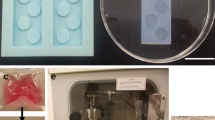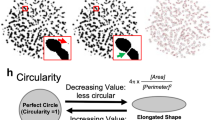Summary
Retinoic acid (RA) has dramatic effects on limb-skeletal patterning in vivo and may well play a pivotal role in normal limb morphogenesis. RA’s effects on the expression of pattern-related genes in the developing limb are probably mediated by cytoplasmic RA-binding proteins and nuclear RA-receptors. Little is known, however, about how RA modifies specific cellular behaviors required for skeletal morphogenesis. Earlier studies supported a role for regional differences in RA concentration in generating the region-specific cell behaviors that lead to pattern formation. The present study explores the possibility that position-related, cell-autonomous differences in the way limb mesenchymal cells respond to RA might have a role in generating pattern-related cell behavior. Mesenchymal cells from different proximodistal regions of stage 21–22 and 23–24 chick wing-buds were grown in chemically defined medium and exposed to 5 or 50 ng/ml of RA for 4 days in high-density microtiter cultures. The effects of RA on chondrogenesis in these cultures clearly differed depending on the limb region from which the cells were isolated. Regional differences in RA’s effects on growth over 4 days in these cultures were less striking. The region-dependent responses of these cells to RA proved relatively stable in culture despite ongoing cytodifferentiation. This serum-free culture model will be useful in exploring the mechanisms underlying the region-dependent responsiveness of these cells to RA.
Similar content being viewed by others
References
Archer, C. W.; Langille, R. M.; Teran, M. A. F., et al. Myogenic potential of chick wing-bud mesenchyme in micromass culture. Anat. Embryol. 185:299–306; 1992.
Biddulph, D. M.; Sawyer, L. M.; Dozier, M. M. Chondrogenesis in chick limb mesenchyme in vitro derived from distal limb bud tips: changes in cyclic AMP and in prostaglandin responsiveness. J. Cell. Physiol. 136:81–87; 1988.
Boylan, J. F.; Gudas, L. J. The level of CRABP-I expression influences the amounts and types of all-trans retinoic acid metabolites in F9 teratocarcinoma stem cells. J Biol. Chem. 267:21486–21491; 1992.
Brunk, C. F.; Jones, K. C.; James, T. W. Assay for nanogram quantities of DNA in cellular homogenates. Anal. Biochem. 92:497–500; 1979.
Caplan, A. I. Effects of the nicotinamide-sensitive teratogen 3-acetylpyridine on chick limb-bud cells in culture. Exp. Cell Res. 62:341–355; 1970.
Chen, Y. P.; Huang, L.; Russo, A. F., et al. Retinoic acid is enriched in Hensen’s node and is developmentally regulated in the early chicken embryo. Proc. Natl. Acad. Sci. USA 89:10056–10059; 1992.
Coelho, C. N. D.; Sumoy, L.; Kosher, R. A., et al. GHox-7: a chicken homeobox-containing gene expressed in a fashion consistent with a role in patterning events during embryonic chick development. Differentiation 49:85–92; 1992.
Dollé, P.; Ruberte, E.; Leroy, P., et al. Retinoic acid receptors and cellular retinoid binding proteins. I. A systematic study of their differential pattern of transcription during mouse organogenesis. Development 110:1133–1151; 1990.
Eichele, G. Retinoids and vertebrate limb pattern formation. Trends Genet. 5:246–251; 1989.
Evans, R. M. The steroid and thyroid hormone receptor superfamily. Science 240:889–895; 1988.
Fiorella, P. D.; Napoli, J. L. Expression of cellular retinoic acid binding protein (CRABP) inEscherichia coli. Characterization and evidence that holo-CRABP is a substrate in retinoic acid metabolism. J. Biol. Chem. 266:16572–16579; 1991.
Greene, S.; Chambon, P. Nuclear receptors enhance our understanding of transcription regulation. Trends Genet. 4:309–314; 1988.
Hamburger, V.; Hamilton, H. L. A series of normal stages in the development of the chick embryo. J. Morphol. 88:49–92; 1951.
Hassell, J. R.; Horigan, E. A. Chondrogenesis: a model developmental system for measuring the teratogenic potential of compounds. Teratogen. Carcinogen. Mutagen. 2:325–331; 1982.
Ide, H.; Aono, H. Retinoic acid promotes proliferation and chondrogenesis in the distal mesodermal cells of chick limb bud. Dev. Biol. 130:767–773; 1988.
Kochhar, D. M. Teratogenic activity of retinoic acid. Acta Pathol. Microbiol. Scand. 70:398–404; 1967.
Kochhar, D. M. Limb development in mouse embryos. 1. Analysis of teratogenic effects of retinoic acid. Teratology 7:289–298; 1973.
Langille, R. M.; Paulsen, D. F.; Solursh, M. Differential effects of physiological concentrations of retinoic acid in vitro on chondrogenesis and myogenesis in chick craniofacial mesenchyme. Differentiation 40:84–92; 1989.
Lee, J.; Tickle, C. Retinoic acid and pattern formation in the developing chick wing: SEM and quantitative studies of early effects on the apical ectodermal ridge and bud outgrowth. J. Embryol. Exp. Morphol. 90:139–169; 1985.
Leonard, C. M.; Bergman, M.; Frenz, D. A., et al. Abnormal ambient glucose levels inhibit proteoglycan core protein gene expression and reduce proteoglycan accumulation during chondrogenesis: possible mechanism for teratogenic effects of maternal diabetes. Proc. Natl. Acad. Sci. USA 86:10113–10117; 1989.
Lev, R.; Spicer, S. S. Specific staining of sulfate groups with alcian blue at low pH. J. Histochem. Cytochem. 12:309; 1964.
Maden, M.; Ong, D. E.; Summerbell, D., et al. Spatial distribution of cellular protein binding to retinoic acid in the chick limb bud. Nature 335:733–735; 1988.
Mangelsdorf, D. J.; Ong, E. S.; Duck, J. A., et al. Nuclear receptor that identifies a novel retinoic acid response pathway. Nature 345:224–229; 1990.
Napoli, J. L.; Posch, K. P.; Fiorella, P. D., et al. Physiological occurrence, biosynthesis and metabolism of retinoic acid: evidence for roles of cellular retinol-binding protein (CRBP) and cellular retinoic acid-binding protein (CRABP) in the pathway of retinoic acid homeostasis. Biomed. Pharmacother. 45:131–143; 1991.
Newman, S. A. Lineage and pattern in the developing wing bud. In: Ede, D. A.; Hinchliffe, J. R.; Balls, M., eds. Vertebrate limb and somite morphogenesis. Cambridge: Cambridge University Press; 1977: 181–200.
Newman, S. A.; Pautou, M.-P.; Kieny, M. The distal boundary of myogenic primordia in chimeric avian limb buds and its relation to an accessible population of cartilage progenitor cells. Dev. Biol. 84:440–448; 1981.
Noji, S.; Nohno, T.; Koyama, E., et al. Retinoic acid induces polarizing activity but is unlikely to be a morphogen in the chick limb bud. Nature 350:83–86; 1991.
Paulsen, D. F.; Parker, C. L.; Finch, R. A. Region-dependent capacity for limb chondrogenesis: patterns of chondrogenesis in cultures from different regions of the developing chick wing. Differentiation 14:159–165; 1979.
Paulsen, D. F.; Langille, R. M.; Dress, V., et al. Selective stimulation of in vitro limb-bud chondrogenesis by retinoic acid. Differentiation 39:123–130; 1988.
Paulsen, D. F.; Solursh, M. Microtiter micromass cultures of limb-bud mesenchymal cells. In Vitro Cell. Dev. Biol. 24:138–147; 1988.
Paulsen, D. F.; Pang, L. Position-related effects of retinoic acid (RA) on chick limb-bud chondrogenesis in serum-free microculture. Anat. Rec. 226:78A; 1990.
Paulsen, D. F.; Chen, W.-D.; Pang, L., et al. Unique responsiveness of distal anterior chick wing-bud mesenchyme to retinoic acid and serum in vitro. Anat. Rec. 229:68A; 1991.
Sakai, A.; Langille, R. M. Differential and stage dependent effects of retinoic acid on chondrogenesis and synthesis of extracellular matrix macromolecules in chick craniofacial mesenchyme in vitro. Differentiation 52:19–32; 1992.
Saunders, J. W., Jr. The proximo-distal sequence of the origin of the parts of the chick wing and the role of the ectoderm. J. Exp. Zool. 108:363–404; 1948.
Schofield, J. N.; Rowe, A.; Brickell, P. M. Position-dependence of retinoic acid receptor-β gene expression in the chick limb bud. Dev. Biol. 152:344–353; 1992.
Slack, J. M. W. We have a morphogen! Nature 327:553–554; 1987.
Smith, S. M.; Eichele, G. Temporal and regional differences in the expression pattern of distinct retinoic acid receptor-β transcripts in the chick embryo. Development 111:245–252; 1991.
Sulik, K. K.; Dehart, D. B. Retinoic acid induced limb malformations resulting from apical ectodermal cell death. Teratology 37:527–537; 1988.
Summerbell, D. The effect of local application of retinoic acid to the anterior margin of the developing chick limb. J. Embryol. Exp. Morphol. 78:269–289; 1984.
Summerbell, D.; Wolpert, L. Cell density and cell division in the early morphogenesis of the chick wing. Nature 239:24–26; 1972.
Suzuki, H. R.; Padanilam, B. J.; Vitale, E., et al. Repeating developmental expression of G-Hox 7, a novel homeobox containing gene in the chicken. Dev. Biol. 148:375–388; 1991.
Thaller, C.; Eichele, G. Identification and spatial distribution of retinoids in the developing chick limb. Nature 327:625–628; 1987.
Tickle, C.; Alberts, B.; Wolpert, L., et al. Local application of retinoic acid to the limb buds mimics the action of the polarizing region. Nature 296:564–566; 1982.
Tickle, C.; Lee, J.; Eichele, G. A quantitative analysis of the effect of all-trans retinoic acid on the pattern of chick wing development. Dev. Biol. 109:82–95; 1985.
Tickle, C.; Crawley, A.; Farrar, J. Retinoic acid application to chick wing buds leads to a dose-dependent reorganization of the apical ectodermal ridge that is mediated by the mesenchyme. Development 106:691–705; 1989.
Umansky, R. The effect of cell population density on the developmental fate of reaggregating mouse limb-bud mesenchyme. Dev. Biol. 13:31–56; 1966.
Wanek, N.; Gardiner, D. M.; Muneoka, K., et al. Conversion by retinoic acid of anterior cells to ZPA cells in the chick wing bud. Nature 350:81–83; 1991.
Yokouchi, Y.; Sasaki, H.; Kuroiwa, A. Homeobox gene expression correlated with the bifurcation process of limb cartilage development. Nature 353:443–445; 1991.
Author information
Authors and Affiliations
Rights and permissions
About this article
Cite this article
Paulsen, D.F., Solursh, M., Langille, R.M. et al. Stable, position-related responses to retinoic acid by chick limb-bud mesenchymal cells in serum-free cultures. In Vitro Cell Dev Biol - Animal 30, 181–186 (1994). https://doi.org/10.1007/BF02631441
Received:
Accepted:
Issue Date:
DOI: https://doi.org/10.1007/BF02631441




